The Pessary Market is estimated to be valued at USD 422.9 million in 2025 and is projected to reach USD 1117.0 million by 2035, registering a compound annual growth rate (CAGR) of 10.2% over the forecast period.
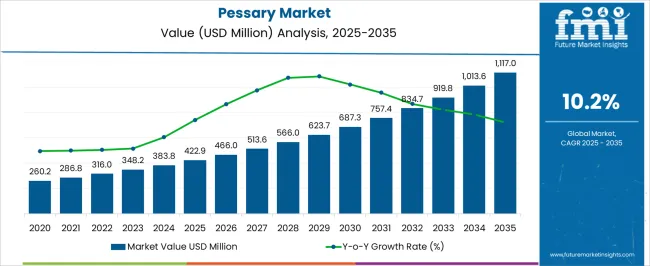
| Metric | Value |
|---|---|
| Pessary Market Estimated Value in (2025 E) | USD 422.9 million |
| Pessary Market Forecast Value in (2035 F) | USD 1117.0 million |
| Forecast CAGR (2025 to 2035) | 10.2% |
The pessary market is experiencing steady growth driven by rising awareness about pelvic organ prolapse and non surgical treatment alternatives among women globally. Increasing geriatric female population, coupled with the prevalence of urinary incontinence and postnatal complications, has led to wider acceptance of pessary devices in clinical care.
Healthcare professionals are increasingly recommending pessaries as first line conservative therapy, especially for patients seeking to avoid or delay surgical interventions. The market is also benefiting from advancements in biocompatible materials that improve patient comfort and reduce infection risks.
Improved healthcare access and training initiatives are further enhancing pessary adoption, particularly in hospital and outpatient settings. The future outlook remains positive as the demand for personalized, less invasive treatments continues to rise, supported by expanding diagnostic capabilities and greater attention to women’s pelvic health.
The market is segmented by Type and End-Use and region. By Type, the market is divided into Gellhorn, Ring, Donut, and Other Types. In terms of End-Use, the market is classified into Hospitals, Ambulatory Surgical Centres, and Clinics. Regionally, the market is classified into North America, Latin America, Western Europe, Eastern Europe, Balkan & Baltic Countries, Russia & Belarus, Central Asia, East Asia, South Asia & Pacific, and the Middle East & Africa.
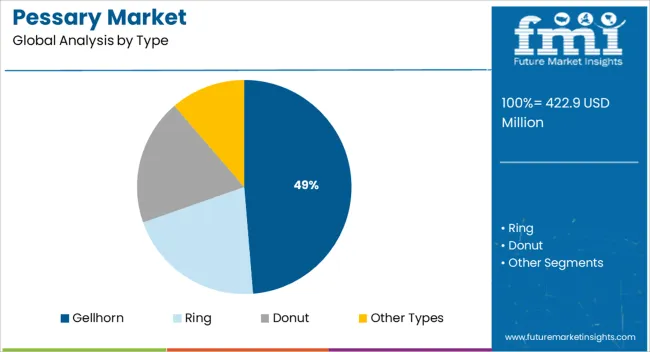
The Gellhorn type segment is projected to represent 48.70% of total market revenue by 2025 within the type category, making it the dominant sub segment. This is due to its effectiveness in treating advanced stages of pelvic organ prolapse and its ability to provide stable anatomical support.
Gellhorn pessaries are favored in cases where other types may dislodge or prove ineffective, particularly for women with more severe symptoms or limited physical mobility. The device’s shape and secure fit reduce the risk of expulsion and provide consistent therapeutic results, which has led to its widespread adoption by healthcare providers.
As clinicians prioritize long term symptom relief and patient quality of life, the Gellhorn pessary continues to lead the type segment based on clinical reliability and treatment outcomes.
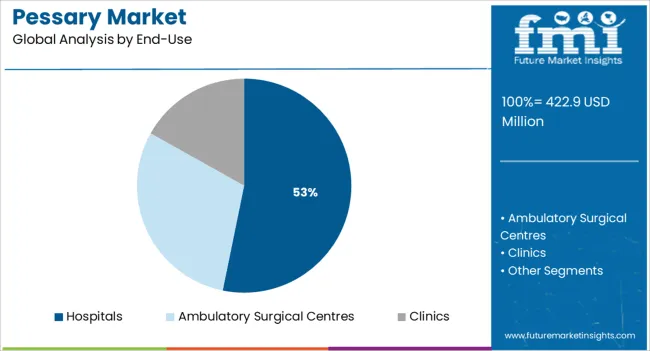
The hospitals segment is expected to account for 53.20% of total market revenue by 2025 under the end use category, positioning it as the leading segment. This dominance is driven by the availability of skilled practitioners, access to diagnostic tools, and structured patient follow up protocols within hospital environments.
Hospitals serve as the primary setting for initial diagnosis, fitting, and training for pessary use, especially for complex cases requiring specialized care. Additionally, hospital based gynecology departments often manage high volumes of prolapse and incontinence cases, reinforcing the routine use of pessaries as part of comprehensive care.
The integration of pessary management into outpatient services and post surgical rehabilitation has further strengthened the segment’s leadership. These factors combined make hospitals the preferred end use setting for pessary treatment and patient care.
As per the Pessary Market research by Future Market Insights - a market research and competitive intelligence provider, historically, from 2020 to 2024, the market value of the Pessary Market increased at around 8.5% CAGR.
The aging population, together with pessaries' high success rate, has been driving the growth of the pessary market. Furthermore, lifestyle-related diseases are becoming more prevalent. The growing prevalence of diseases like pelvic organ prolapse and urinary incontinence will drive the pessary market. Furthermore, growing global awareness of the importance of pessaries during pelvic organ prolapse complications will serve as a growth driver.
For women with POP who want nonsurgical management, a future pregnancy, early-stage prolapse, or are too frail for surgery, pessaries are typically recommended as a first-line treatment option. Patients whose stress incontinence is aggravated by strenuous physical activity may benefit from pessaries. Pessaries provide an opportunity to simulate postsurgical conditions and help patients' expectations regarding symptom reduction in women who present with pelvic pain, back pain, and pressure thought to be caused by POP operations.
Several studies on the success rate of pessary fitting have been conducted, with results ranging from 41% to 74%. Success rates as high as 62 percent have been observed in patients with stage III and IV prolapse, suggesting that pessaries are an excellent option for all populations with severe POP. In the United States, approximately 200,000 POP operations are performed each year. Although not life-threatening, POP could have a major impact on women's standard of living.
The Fourth International Consultation on Incontinence recommends pessaries, pelvic floor muscle training, and lifestyle counseling as conservative management options for women with Pelvic Organ Prolapse. Vaginal vault prolapse, or some other type of pelvic organ prolapse, affects approximately half of the women aged 50 to 80 years. Childbirth, age, fatness, gastrointestinal issues, or a hysterectomy can all cause uterine prolapse and increase the demand for pessaries.
Because they provide simple, affordable, and safe solutions, vaginal pessaries are a popular treatment option for organ prolapse and incontinence. These factors contribute to the higher patient satisfaction rate in comparison to an alternate solution. As a result, pessaries are now preferred as first-line treatment for POP or stress urinary incontinence.
Among the key factors expected to drive the market during the forecast period are frequent product introductions, a strong emphasis on Research and Development by market players and universities, geographical expansion by key players, and a number of government initiatives.
The United Kingdom Clinical Guideline for Proper Procedure in the Use of Vaginal Pessaries for POP is a document prepared by medical professionals and supporters of prolapse pessaries. The goal of the Guideline is to provide multidisciplinary healthcare professionals with guidance and information on best practices in pessary use for prolapse.
Pessaries are now made of non-reactive silicone and come in a variety of designs and sizes to accommodate everyone. Silicon has low surface tension and remarkable chemical stability, allowing for biocompatibility and bio-durability in many long-term implant applications, making it suitable for medical applications.
Pessaries can be used as a stopgap measure for women who want to stop having children or are waiting for surgery. It can also be used as a long-term solution for women who do not qualify for surgery.
In June 2024, using artificial intelligence-driven machine learning and 3D design, Femtherapeutics Inc. developed a device to relieve urinary incontinence and discomfort in women suffering from pelvic organ prolapse. Unlike traditional pessaries, which can cause irritation and penetrate soft tissues, resulting in bleeding, the custom-made pessary is intended to support displaced vaginal tissues caused by the condition.
Asia Pacific is the most lucrative region with double-digit projected growth. The fastest rate of expansion in the regional finance industry is predicted to result from younger, expanding populations and a growing focus on wellness.
As the elderly are more prone to incontinence and prolapsed organ disorders (POP), there is a sizable market in this region, with Japan, China, and India being the primary suppliers. Medical tourism is also a key driver behind the market's growth here.
In developing countries, the extent and effects of morbidity associated with pelvic organ prolapse are rarely acknowledged due to patient embarrassment. However, research funded by the United Nations Population Fund (UNFPA) in Nepal has begun to identify the suffering of women from this disorder. UNFPA is assisting in the identification of women with pelvic organ prolapse through reproductive health camps and the hiring of gynecologists to treat these women at district hospitals.
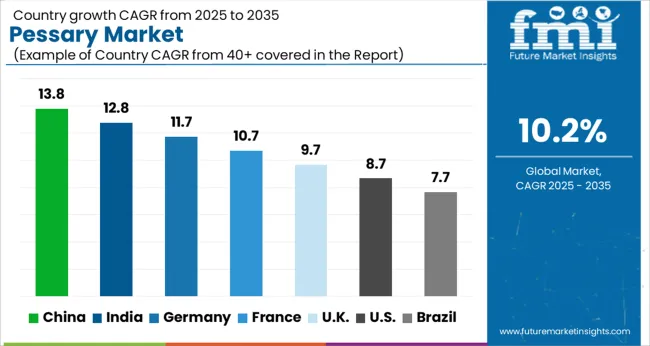
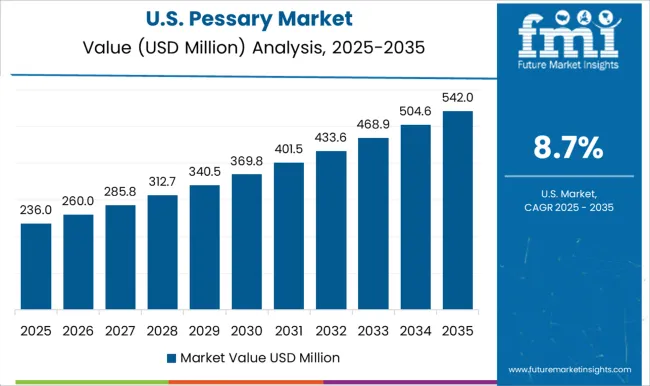
The USA is expected to have the largest market of USD 1117 Million by the end of 2035 with North America being the dominant player and accounting for over 35% of total sales. With the elderly population in the United States increasing, there is renewed interest in pessaries as a less invasive alternative to surgical repair for pelvic organ prolapse (POP).
They are an excellent choice for women who have not finished having children, do not want surgery, or are ineligible for surgery. Patients suffering from POP and stress urinary incontinence may benefit from long-term pessary use. Although serious side effects are uncommon, many patients find it difficult to insert and remove most pessary types. The design of pessaries should continue to improve, making their use more appealing.
Women in the USA have an 11% lifetime risk of having prolapse or incontinence surgery by the age of 80, with a 30% chance of reoperation after four years. The number of women over the age of 65 in the USA is expected to more than double to reach more than 1117 million by 2035, according to the USA Census Bureau.
As the United States population ages, there is renewed interest in the use of pessaries. According to a survey conducted by the American Urogynaecology Society, 77% of those polled used pessaries as their first-line POP therapy. The pessary is still a viable treatment option for prolapse and incontinence.
The market in the United Kingdom is expected to gross USD 42 Million by 2035. The market in the country is expected to witness a CAGR of 12.1% during the forecast period, registering an absolute dollar opportunity of USD 28.2 Million.
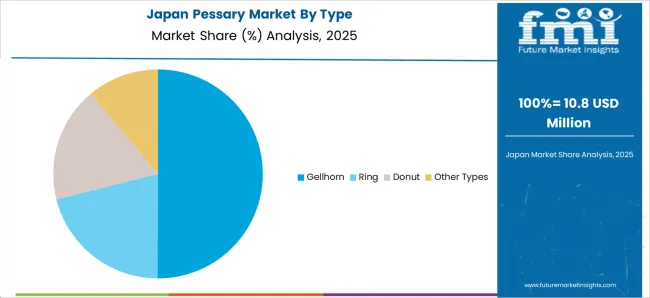
In Japan, the market is expected to reach a valuation of USD 30 Million by 2035. With an absolute dollar opportunity of USD 20.7 Million during the forecast period, the market is expected to register a CAGR of 12.7%.
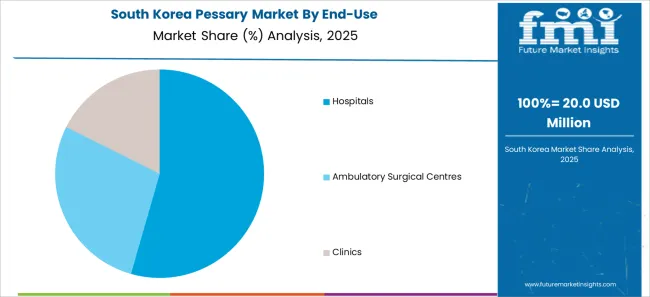
The market in South Korea is expected to gross an absolute dollar opportunity of USD 9.9 Million by 2035. Growing at a CAGR of 10.8% from 2025 to 2035, the market is likely to reach a valuation of USD 15.5 Million.
The Ring Pessary segment is forecasted to grow at the highest CAGR of over 11% from 2025 to 2035. Because of their ease of insertion and removal, ring pessaries are typically the first-line pessary for clinicians. They can be used at any stage of POP, but the first and second stages are the most common.
The catheter is unfolded once above the pubic symphysis after being inserted into the vagina. The pessary is gently pulled and folded in half to be removed. To help with insertion and removal, a string can be attached to the ring. Patients can easily learn how to do this on their own.
A new disposable, non-invasive vaginal ring pessary is used at home to treat a variety of pelvic floor disorders. The ConTIPI Medical ProVate, for example, is made of a flexible skeleton covered by a soft elastomer and is designed to expand in the vagina, separating the lateral vaginal walls and mechanically preventing cervical and vault descent as well as blocking further descent of the anterior and posterior walls within the rings hollow.
The Hospitals segment is forecasted to grow at the highest CAGR of over 11.4% from 2025 to 2035. With 45% of the total revenue, the hospital segment dominated the vaginal pessary market. This could be attributed to the rising market demand for pessaries among post-operative and hospitalized indwellings.
Among factors contributing to the segment's growth is the heightened interest in the notion of organ prolapse, urinary incontinence, and the inclusion of pessaries in private insurance policies. Surgeons are increasingly favoring minimally invasive procedures that will limit post-operation complications and increase recovery times.
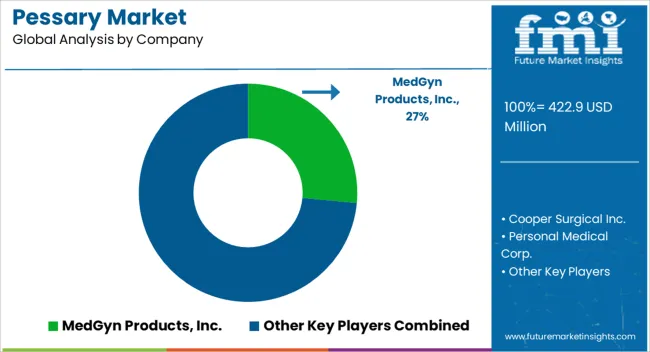
Among the leading players in the global Pessary market are Integra Lifesciences, Panpac Medical Corporation, Personal Medical Corporation, Dr. Arabin GmbH & Co., and Wallach Surgical Devices. To gain a competitive advantage in the industry, these market players are investing in product launches, partnerships, mergers and acquisitions, and expansions.
Some of the recent developments in the pessary market are mentioned below:
The Liv Labs pessary is soft, smooth, and squishy, making insertion and removal easier. It is made of medical-grade silicone. Women can use it whenever they want, whether it is all day or just for a quick trip to the gym.
Similarly, the team at Future Market Insights, which is available in the full report, has tracked recent developments related to companies in the Pessary market
The global pessary market is estimated to be valued at USD 422.9 million in 2025.
The market size for the pessary market is projected to reach USD 1,117.0 million by 2035.
The pessary market is expected to grow at a 10.2% CAGR between 2025 and 2035.
The key product types in pessary market are gellhorn, ring, donut and other types.
In terms of end-use, hospitals segment to command 53.2% share in the pessary market in 2025.






Our Research Products

The "Full Research Suite" delivers actionable market intel, deep dives on markets or technologies, so clients act faster, cut risk, and unlock growth.

The Leaderboard benchmarks and ranks top vendors, classifying them as Established Leaders, Leading Challengers, or Disruptors & Challengers.

Locates where complements amplify value and substitutes erode it, forecasting net impact by horizon

We deliver granular, decision-grade intel: market sizing, 5-year forecasts, pricing, adoption, usage, revenue, and operational KPIs—plus competitor tracking, regulation, and value chains—across 60 countries broadly.

Spot the shifts before they hit your P&L. We track inflection points, adoption curves, pricing moves, and ecosystem plays to show where demand is heading, why it is changing, and what to do next across high-growth markets and disruptive tech

Real-time reads of user behavior. We track shifting priorities, perceptions of today’s and next-gen services, and provider experience, then pace how fast tech moves from trial to adoption, blending buyer, consumer, and channel inputs with social signals (#WhySwitch, #UX).

Partner with our analyst team to build a custom report designed around your business priorities. From analysing market trends to assessing competitors or crafting bespoke datasets, we tailor insights to your needs.
Supplier Intelligence
Discovery & Profiling
Capacity & Footprint
Performance & Risk
Compliance & Governance
Commercial Readiness
Who Supplies Whom
Scorecards & Shortlists
Playbooks & Docs
Category Intelligence
Definition & Scope
Demand & Use Cases
Cost Drivers
Market Structure
Supply Chain Map
Trade & Policy
Operating Norms
Deliverables
Buyer Intelligence
Account Basics
Spend & Scope
Procurement Model
Vendor Requirements
Terms & Policies
Entry Strategy
Pain Points & Triggers
Outputs
Pricing Analysis
Benchmarks
Trends
Should-Cost
Indexation
Landed Cost
Commercial Terms
Deliverables
Brand Analysis
Positioning & Value Prop
Share & Presence
Customer Evidence
Go-to-Market
Digital & Reputation
Compliance & Trust
KPIs & Gaps
Outputs
Full Research Suite comprises of:
Market outlook & trends analysis
Interviews & case studies
Strategic recommendations
Vendor profiles & capabilities analysis
5-year forecasts
8 regions and 60+ country-level data splits
Market segment data splits
12 months of continuous data updates
DELIVERED AS:
PDF EXCEL ONLINE

Thank you!
You will receive an email from our Business Development Manager. Please be sure to check your SPAM/JUNK folder too.
Chat With
MaRIA